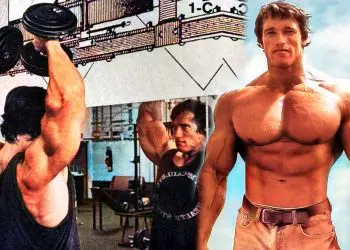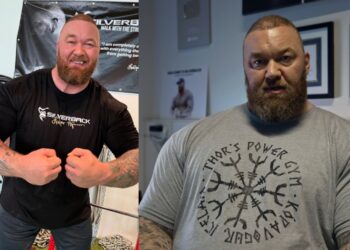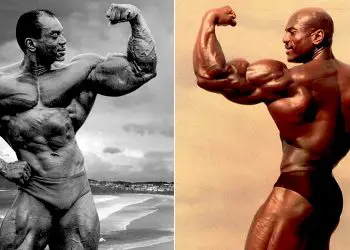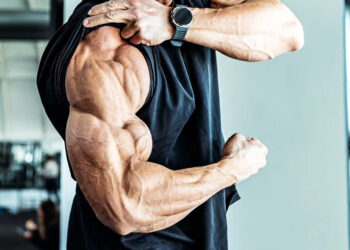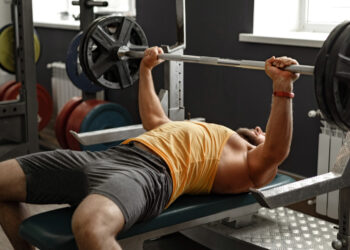While the shoulders and biceps are two of the smallest upper body muscles, they often have the biggest impact on how you look – especially when you’re rocking your cut-off T-shirt or sleeveless vest.
A lot of people like to train their shoulders with their chests, and their biceps with their back, but this is not necessarily the best approach. If your shoulders and biceps are lagging behind the rest of your body, they deserve a workout where they get the starring role.
In this article, we reveal our favorite shoulder and biceps workout for strength and size. Do it weekly for the best results!
Shoulder and Biceps Anatomy
While you don’t need a degree in anatomy and physiology to build impressive shoulders and biceps, knowing a little more about these muscle groups may help make your workouts more effective. If nothing else, you’ll be able to dazzle your workout buddies with your newly acquired anatomical knowledge!
Shoulders
The correct name for the muscles of your shoulders is the deltoids. There are three sets of fibers that make up the deltoids, which are commonly referred to as heads. The deltoid heads work together to control your shoulder joint. Still, they can also be emphasized individually with certain exercises and movements.
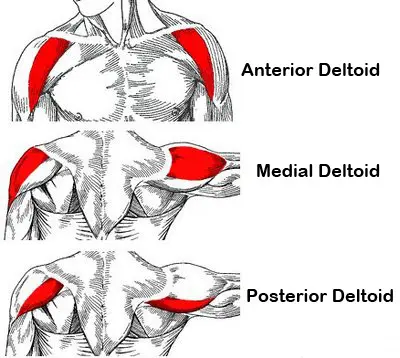
The three deltoid heads are:
Level Up Your Fitness: Join our 💪 strong community in Fitness Volt Newsletter. Get daily inspiration, expert-backed workouts, nutrition tips, the latest in strength sports, and the support you need to reach your goals. Subscribe for free!
Anterior deltoid – located on the front of your shoulders, the anterior deltoid flexes and medially rotates your upper arm. Exercises that emphasize this head include front raises and overhead presses.
Medial deltoids – the medial or middle deltoid is located on the side of your shoulder joint. Its function is to abduct your upper arm, meaning it raises your arm up and out to the side. The medial deltoid gives your shoulders their width. Exercises that target the medial deltoid include dumbbell and cable side raises.
Posterior deltoid – also known as the rear deltoid, this head is located on the back of your shoulder. It works in opposition to the anterior deltoid and is responsible for shoulder joint extension and external rotation. Exercises that target the posterior deltoid include reverse dumbbell flys and reverse cable crossovers.
Biceps
You probably already know more than enough about your biceps. After all, it’s the most famous muscle in the human body. Even non-lifters can usually identify their biceps and are happy to throw up an arm and flex for a biceps pose!
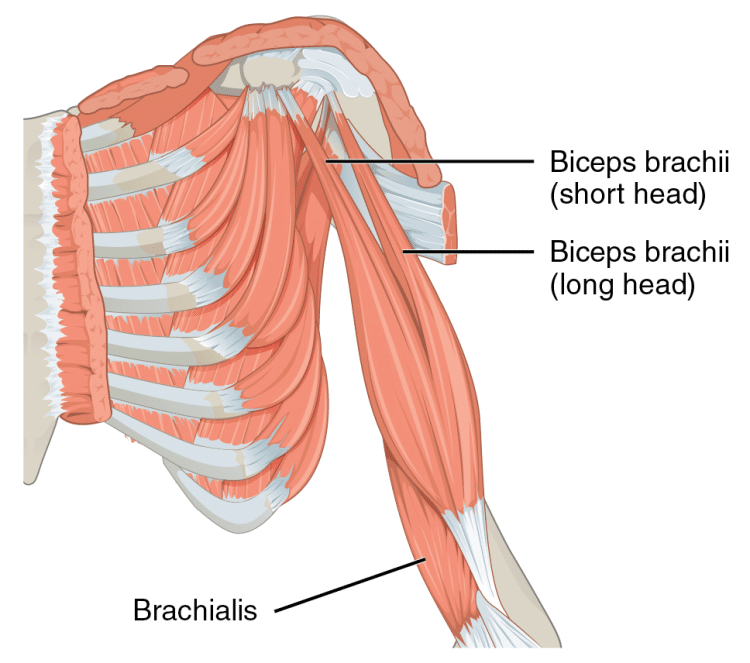
Still, we’ve told you all about the deltoids, so it’s only fair that the biceps get the same treatment…
Biceps brachii – the full name for the muscle on the front of your upper arm is biceps brachii, which means two-headed arm muscle. Known as the biceps for short, this muscle is responsible for flexion of the elbow, flexion of the shoulder, and supination of the forearm. The biceps have two heads (the long head and the short head) which refer to where they attach onto the shoulder joint.
Shoulder and Bicep Workout – Overview
This workout is designed to be done as part of a body part split routine, where you train different muscles on different days. For example, you might train your chest one day, your legs the next, and then hit your shoulders and biceps a day later.
You can do this workout once or twice a week as needed. Do it twice if you want to build your shoulders and arms more quickly. However, avoid hitting the same muscles on consecutive days, as they need time to recover between workouts.
But, before hitting the weights, make sure you spend a few minutes warming up and preparing your body and mind for what you’re about to do.
Begin with 5-10 minutes of easy cardio, such as rowing, air bike, elliptical, or jump rope. Next, do some dynamic mobility and flexibility exercises for the muscles and joints you’re about to use. Finally, end your warm-up with 2-3 sets of the first exercise of the workout.
All warmed up? Good job! Now you are ready, let’s get to work! Here is your shoulder and biceps workout for strength and size.
| # | Exercise | Sets | Reps | Recovery |
| 1 | Barbell military press | 4 | 6 | 2 minutes |
| 2a | Dumbbell lateral raise | 3 | 12 | 90 seconds |
| 2b | Face pull | |||
| 3 | Seated dumbbell clean and half-press | 3 | 15 | 60 seconds |
| 4 | EZ barbell curl | 3 | 8 | 90 seconds |
| 5 | Supine cable curl | 3 | 10 | 60 seconds |
| 6 | Dumbbell concentration curl | 3 | 12 | 60 seconds |
| 7 | Dumbbell hammer curl and press | 1 | 50 | N/A |
Exercises 2a and 2b are to be performed as a superset. Do a set of dumbbell lateral raises and then, without resting, immediately do a set of face pulls. Rest for the prescribed time and then repeat the pairing for the specified number of supersets.
Exercise Descriptions
There are two ways to do any exercise – the right way and the wrong way. The right way is safe and effective, putting plenty of muscle and strength-building tension on the target muscles and not on your joints. The wrong way increases the risk of injury and may not be as effective. So, when given a choice, you should always do the exercises in your workout the right way.
Follow these step-by-step instructions to get the most from all the exercises in your shoulder and biceps workout.
Level Up Your Fitness: Join our 💪 strong community in Fitness Volt Newsletter. Get daily inspiration, expert-backed workouts, nutrition tips, the latest in strength sports, and the support you need to reach your goals. Subscribe for free!
1. Barbell military press
The barbell military press is your main shoulder strength builder. Because it’s a compound exercise, it works all three deltoid heads as well as your triceps, so you should be able to lift reasonably heavy weights.
The military press is a strict exercise, and you must not use your legs to help you lift the weight. Instead, keep them straight, like a soldier standing to attention, which is where this movement gets its name.
How to do it:
- Hold a barbell with a slightly wider than shoulder-width grip. Use a false or thumbless grip if you find it more comfortable.
- Position the barbell in front of your shoulders, so your elbows are slightly in front of the bar. Stand with your feet hip-width apart, legs straight, and abs braced. Pull your shoulders down and back.
- Without bending your legs or moving your feet, press the bar straight up and overhead to arms’ length.
- Lower it back to your shoulders and repeat.
2a. Dumbbell lateral raise
Dumbbell lateral raises target your medial deltoids. Well-developed medial deltoids will add a lot of width to your shoulders. This exercise is the first part of a superset, so move your dumbbells over to wherever you’ll be performing the next exercise (face pulls).
How to do it:
- Hold a dumbbell in each hand with your arms by your sides and your hands facing your legs. Bend your arms slightly but then keep them rigid.
- Stand with your feet about shoulder-width apart, knees slightly bent, and core braced. Pull your shoulders down and back.
- Raise your arms up and out to the side until they are roughly parallel to the floor.
- Lower the weights back down to your sides and repeat.
2b. Face pull
Working your posterior deltoids, face pulls also hit the muscles across and between your shoulder blades, which are the middle trapezius and rhomboids. As such, this exercise is not just good for your shoulders but your posture, too.
How to do it:
- Attach a rope handle to a chest-high pulley machine. Hold the handle and, with your arms straight, take a step back to tension the cable. Pull your shoulders down and back and brace your abs.
- Keeping your arms up, bend your elbows and pull the ends of the handle into the side of your head. Imagine you are trying to stick your thumbs in your ears. Pull your shoulders back.
- Extend your arms and repeat.
3. Seated dumbbell clean and half-press
Most people do clean and presses with a barbell and while standing. This seated variation uses dumbbells, so you’ll need to work extra hard to lift and stabilize the weights. This exercise will produce a deep burn and pump in all three deltoid heads.
How to do it:
- Sit on an exercise bench with your feet flat on the floor and a dumbbell in each hand.
- Without rounding your lower back, lean forward and lower the weights a little closer to the floor.
- Sit up explosively and use this momentum to help you lift the dumbbells up to your shoulders, palms facing forward.
- Press the dumbbells part way up so they’re just above the level of your head. Do not lock your arms, as doing so will take tension off your deltoids.
- Lower the weights back down to your sides and repeat.
4. EZ barbell curl
Straight barbell curls are an excellent biceps exercise, but they can be hard on your elbows. Using an EZ bar takes stress off your joints and allows you to really focus on working your biceps as hard as you can.
The semi-supinated grip also increases brachialis and brachioradialis engagement, which are smaller but no less important arm muscles.
How to do it:
- Hold the bar with a shoulder-width underhand grip. Your thumbs should be slightly higher than your little fingers, i.e., a semi-supinated grip.
- Stand with your feet about shoulder-width apart, abs braced, and shoulders pulled down and back. Your arms should be straight.
- Without using your legs or back to lift the weight, bend your elbows and curl the bar up to your shoulders.
- Extend your arms, lower the bar, and repeat.
5. Supine cable curl
Even with the most determined will, almost every lifter will use their legs and back to lift the bar during biceps curls. This exercise eliminates all possibilities of cheating and also keeps your biceps under constant tension to deliver an excellent upper arm workout.
How to do it:
- Attach a straight or cambered EZ bar to a low cable machine. Sit on the floor with your legs straight and grab the handle with an underhand, shoulder-width grip. Lie down, so your back is flat on the floor. Pull your shoulders down and back.
- Bend your elbows and curl the handle up to your shoulders.
- Extend your arms and repeat.
6. Dumbbell concentration curl
According to the American Council on Exercise, or ACE for short, concentration curls are the best biceps exercise you can do. In studies, this exercise produced the most significant degree of muscle activation. However, because it uses relatively light weights, it’s best left to the end of your workout when your biceps are beginning to fatigue.
How to do it:
- Sit on an exercise bench with a dumbbell in one hand.
- Lean forward and place your upper arm against the inside of your thigh. Let the weight hang down toward the floor.
- Keeping your arm against your inner thigh, bend your elbow and curl the weight up to your shoulder.
- Lower the arm and repeat.
- Use your non-working arm to provide assistance to squeeze out a couple of extra reps once you reach failure. This is a form of self-spotting.
7. Dumbbell hammer curl and press
This is your final exercise. It works your shoulders and biceps at the same time. Instead of doing regular sets and reps, this is a high-rep finisher. Simply grab a weight that you can use for 12-15 reps and then try to crank out 50 reps in as few sets as possible. Don’t be surprised if this leaves your shoulders and your biceps pumped and burning – that’s kinda the point!
How to do it:
- Seated or standing, hold a dumbbell in each hand with your arms down by your sides. Your palms should be facing your legs.
- Bend your arms and curl the dumbbells up to your shoulders. Do not rotate your wrists.
- Next, press the weights up and overhead.
- Lower the dumbbells back to your shoulders and then down to your sides.
- That’s one rep – only 49 left to do!
- Shoulder and Biceps Workout at Home
- Big Delts Fast: 30-Minute Shoulder Workout
- Chest and Shoulder Workout For Upper Body Size and Strength
- Kai Greene BOULDER Shoulders Workout
- Top 15 Biceps Peak Exercises For Building Monster Arms
- 9 Best Cable Exercises for Bigger Biceps
- 7 Best Back and Biceps Workouts for Strength and Mass
Wrapping Up
Big shoulders and muscular arms don’t just happen by accident. You need to work hard if you want to build the upper body of your dreams! This workout will add mass to your deltoids and biceps and increase your strength, so you don’t just look strong but ARE strong!
Combine this workout with your favorite split routine, train hard, eat right, get plenty of sleep, and you’ll soon be on your way to building an impressive upper body.


